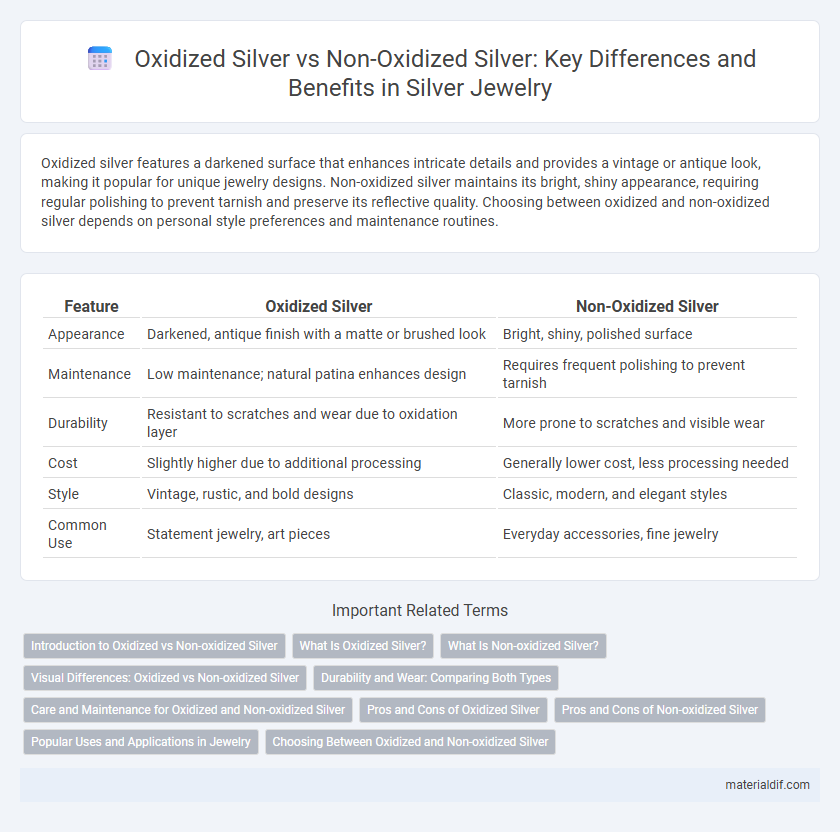Oxidized silver features a darkened surface that enhances intricate details and provides a vintage or antique look, making it popular for unique jewelry designs. Non-oxidized silver maintains its bright, shiny appearance, requiring regular polishing to prevent tarnish and preserve its reflective quality. Choosing between oxidized and non-oxidized silver depends on personal style preferences and maintenance routines.
Table of Comparison
| Feature | Oxidized Silver | Non-Oxidized Silver |
|---|---|---|
| Appearance | Darkened, antique finish with a matte or brushed look | Bright, shiny, polished surface |
| Maintenance | Low maintenance; natural patina enhances design | Requires frequent polishing to prevent tarnish |
| Durability | Resistant to scratches and wear due to oxidation layer | More prone to scratches and visible wear |
| Cost | Slightly higher due to additional processing | Generally lower cost, less processing needed |
| Style | Vintage, rustic, and bold designs | Classic, modern, and elegant styles |
| Common Use | Statement jewelry, art pieces | Everyday accessories, fine jewelry |
Introduction to Oxidized vs Non-oxidized Silver
Oxidized silver features a darkened surface created by a controlled chemical reaction that enhances intricate designs and adds vintage appeal. Non-oxidized silver retains its natural shiny, reflective finish, requiring frequent polishing to maintain its brightness. Understanding the differences in appearance and maintenance helps in choosing the right silver for jewelry, decor, or collectible items.
What Is Oxidized Silver?
Oxidized silver is sterling silver that has undergone a chemical process to create a darkened, tarnished finish, enhancing the metal's texture and design details. This intentional oxidation provides an antique or vintage look, increasing contrast on intricate patterns and making jewelry pieces stand out more vividly. Unlike non-oxidized silver, which retains its bright, polished shine, oxidized silver intentionally darkens surface areas to emphasize craftsmanship and style.
What Is Non-oxidized Silver?
Non-oxidized silver refers to silver that has not undergone any intentional chemical treatment to develop a darkened, tarnished appearance. Unlike oxidized silver, which is treated to enhance contrast and detail by creating a blackened layer on the surface, non-oxidized silver maintains its natural, bright, and shiny luster. This untreated silver is prized for its classic, reflective finish that highlights its pure metallic qualities without any patina effects.
Visual Differences: Oxidized vs Non-oxidized Silver
Oxidized silver features a darkened, matte finish created by a controlled tarnishing process that enhances intricate details and antique aesthetics. Non-oxidized silver has a bright, reflective surface showcasing a polished, shiny appearance with a modern and sleek look. Visual contrast between the two highlights oxidized silver's depth and texture versus non-oxidized silver's smooth and luminous qualities.
Durability and Wear: Comparing Both Types
Oxidized silver features a darkened surface that enhances scratch resistance and hides everyday wear, making it more durable for frequent use. Non-oxidized silver maintains its bright, shiny appearance but is more prone to visible scratches and tarnishing over time without regular maintenance. Choosing between oxidized and non-oxidized silver depends on balancing a desire for low-maintenance durability versus a polished, reflective finish.
Care and Maintenance for Oxidized and Non-oxidized Silver
Oxidized silver requires gentle cleaning with mild soap and a soft cloth to preserve its darkened patina, avoiding abrasive materials that can remove the oxidized layer. Non-oxidized silver benefits from regular polishing with a silver cloth or cleaner to prevent tarnish and maintain its bright shine. Both types should be stored in airtight containers or anti-tarnish bags to minimize exposure to air and moisture, which cause discoloration.
Pros and Cons of Oxidized Silver
Oxidized silver features a darkened, antique-like finish that enhances intricate details and adds a vintage aesthetic to jewelry and decorative items. Its patina provides a protective layer against further tarnishing, but the darkened surface may require regular cleaning to maintain its appearance and can be less versatile in matching with other accessories compared to non-oxidized silver. Non-oxidized silver offers a bright, shiny look that is more traditional and easier to care for, but it is more prone to visible scratches and tarnish without protective treatment.
Pros and Cons of Non-oxidized Silver
Non-oxidized silver features a bright, reflective finish that highlights its natural luster and requires less maintenance than oxidized silver, which can tarnish over time. However, it is more prone to visible scratches and fingerprints, demanding regular polishing to maintain its shine. Non-oxidized silver jewelry offers a classic aesthetic but lacks the antiqued look and subtle depth provided by oxidization.
Popular Uses and Applications in Jewelry
Oxidized silver is prized in jewelry for its dark, antique finish that enhances intricate designs and adds depth to rings, bracelets, and pendants. Non-oxidized silver, known for its bright and shiny appearance, is commonly used in classic, minimalist jewelry pieces like chains and studs for a sleek and modern look. Both types capitalize on silver's malleability and hypoallergenic properties, catering to diverse aesthetic preferences and fashion trends.
Choosing Between Oxidized and Non-oxidized Silver
Choosing between oxidized and non-oxidized silver depends on the desired aesthetic and maintenance preferences. Oxidized silver features a darkened, antique finish that enhances detailed designs and resists visible scratches, while non-oxidized silver offers a bright, polished look requiring regular cleaning to prevent tarnish. Consider lifestyle and jewelry care routines when selecting the best silver type for long-lasting beauty and durability.
Oxidized Silver vs Non-oxidized Silver Infographic

 materialdif.com
materialdif.com